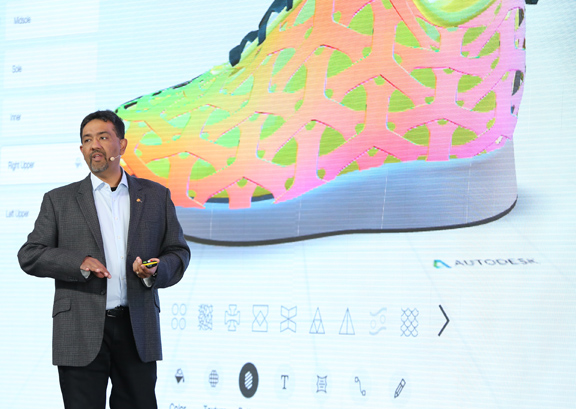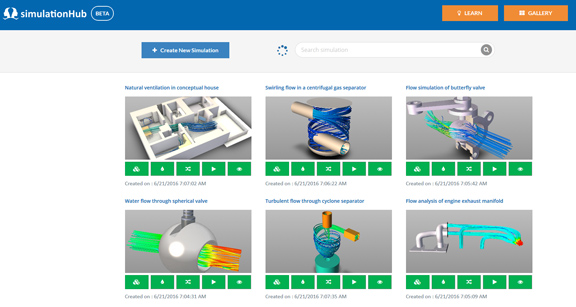
Amar Hanspal at Autodesk’s Forge DevCon. Since Autodesk has no plan to go after special verticals, like the shoe industry, it leaves the window of opportunity open for developers.
Latest News
June 21, 2016
 Amar Hanspal, Autodesk’s senior VP or products, at Autodesk’s Forge DevCon. Since Autodesk has no plan to go after special verticals, like the shoe industry, it leaves the window of opportunity open for third-party developers.
Amar Hanspal, Autodesk’s senior VP or products, at Autodesk’s Forge DevCon. Since Autodesk has no plan to go after special verticals, like the shoe industry, it leaves the window of opportunity open for third-party developers. Simulation apps from simulationHub, developed using Autodesk Forge APIs.
Simulation apps from simulationHub, developed using Autodesk Forge APIs.On a sunny day by the San Francisco Bay, coders, hackers, and developers began arriving at the Fort Mason Festival Pavilion for Forge DevCon, Autodesk’s first-ever developer conference.
“We’re probably not going to go after the shoe industry by building something called AutoShoe,” said Amar Hanspal, senior VP of products. “But perhaps one of you might.”
If you think you have a winning idea for a vertical market, you might try your hand at developing an app or a custom solution on Autodesk’s Forge platform. That’s Autodesk’s proposition to the attendees.
Autodesk builds design software that are applicable to a wide user base. It focuses on three major sectors: product design; architecture and construction; and media and entertainment. The company usually doesn’t go after highly specialized verticals, like footwear comfort analysis. That leaves pockets of opportunities for app developers with sufficient knowledge in niche markets.
The Forge platform comes with the support and industry muscle of Autodesk. Perhaps more important, apps developed on it will find a ready-made market in the people using Autodesk products.
Hanspal said, “Forge is a set of APIs made especially for manufacturing and building industries. It’s made for the cloud. It spans modeling, drawing, visualization, simulation, IoT—all the data-centric operations people can assemble to build applications.”
The Forge developer program has three tiers: Explore (free); Build ($400/month); and Scale ($20K/month).
These levels come with different consumption, storage, and usage allocations. For instance, the free Explore level gives you 25 uploads for Data Management API; but that allocation increases to 15,000 under the Scale level. Similarly, you get 1 CPU hour under the free Explore level for Design Automation API; but you get a whopping 1,250 hours under the Scale level.
To recruit, Autodesk is currently offering free access to the platform—that is, free until September 15. “We’re giving you access to the raw materials that we ourselves use to build our own products,” said Hanspal.
To cultivate a groundswell, Autodesk has set aside as much as $100 million to support startups, innovators, and developers. The company wrote, “We believe the future of making things will be powered by a highly connected, friction-less ecosystem that will enable designers, makers, engineers, and everyone involved to seamlessly collaborate across the entire product development lifecycle ... Whether you’re using our cloud APIs to build a new business or taking your business into the cloud, join us in building the future together.”
Companies at the “investment stage” are invited to pitch to receive funding under this program.
On the show floor, Vic Sanchez stood behind a table to demonstrate openBoM, a cloud-hosted browser-based app to manage bill of materials (BOM). “I think we may have been one of the early adopters of Forge,” he observed.
Sanchez and Oleg Shilovitsky cofounded a new business under the name Newman Cloud and launched openBoM in April 2016. Explaining the motivation, they wrote, “BOMs usually end up as spreadsheets, however. We are taking BOM management to the cloud. Doing so enables the interlinking of BOMs, making them shareable and reference-able in ways that transcends technical drawings. That will mean sharing purely tabular data with colleagues in procurement or linking BOM data to ERP or MRP systems.”
But Shilovitsky and Sanchez are no stranger to the Autodesk ecosystem. Inforbix, the previous company they cofounded, was acquired by Autodesk in August 2012. The assets of Inforbix has since been integrated into Autodesk’s own offerings under the PLM 360 brand.
Developed with access to Autodesk APIs, openBoM can read and import the metadata from Autodesk Inventor files, which makes BOM creation faster and more accurate. openBoM has also established a partnership with Onshape, a browser-based CAD program founded by a team of SolidWorks veterans.
A few yards away from openBoM, Sandip Jadhav showcased a collection of cloud-hosted simulation programs. Jadhav, CEO of simulationHub, built a series of simulation apps based on Forge APIs.
The collection, currently available as beta tests, includes ventilation analysis for conceptual houses, flow simulation for butterfly valves, and turbulent flow analysis for cyclone separators. The preconfigured templates allow people with limited expertise in simulation to conduct specific types of analysis without learning or purchasing a general purpose computational fluid dynamic (CFD) package. Since Jadhav’s apps run in the browser, users don’t need to invest in robust hardware, usually a requirement with using CFD software as a local installation.
The Forge initiative expands Autodesk’s role in the design software business. In addition to developing and marketing its own products, Autodesk will now be a platform provider for other developers. And its software, like Autodesk Fusion 360 and Autodesk Inventor, may become the data-spouting, geometry-transforming engines that power Forge developers’ apps.
It’s worth remembering that AutoCAD, the backbone of Autodesk’s business and its flagship design software, evolved into a platform when developers began creating plug-ins and add-ons for their own industries. The third-party developers expanded the reach of AutoCAD significantly with their custom apps. openBoM’s Shilovitsky was once an AutoCAD app developer.
The Forge event is billed as “Code. Meet Make.” But it may not be so easy for developers with limited renown to get the attention of the makers in the Autodesk universe. In the Q&A session, Hanspal acknowledged the challenge. “The best thing we can do for you [Forge developers] is to help you find customers, to connect what you’ve developed with the people looking for that kind of solution. That can take the form of an app store, or integration,” he said.
But currently there’s no formal mechanism—like a Forge app store populated with a list of products vetted and already blessed by Autodesk—to spread the word. So developers like Shilovitsky and Jadhav must put in a lot more work to be discovered.
Subscribe to our FREE magazine, FREE email newsletters or both!
Latest News
About the Author
Kenneth Wong is Digital Engineering’s resident blogger and senior editor. Email him at [email protected] or share your thoughts on this article at digitaleng.news/facebook.
Follow DE





